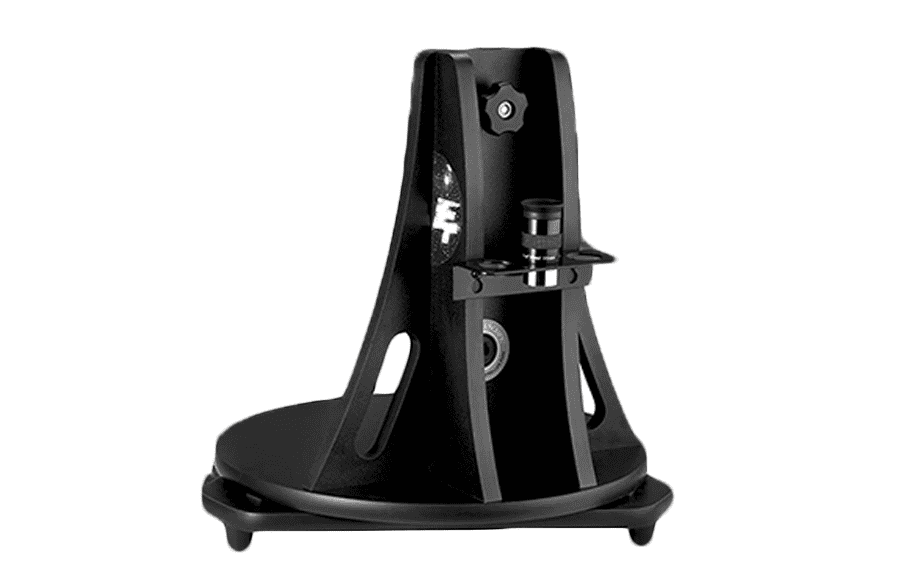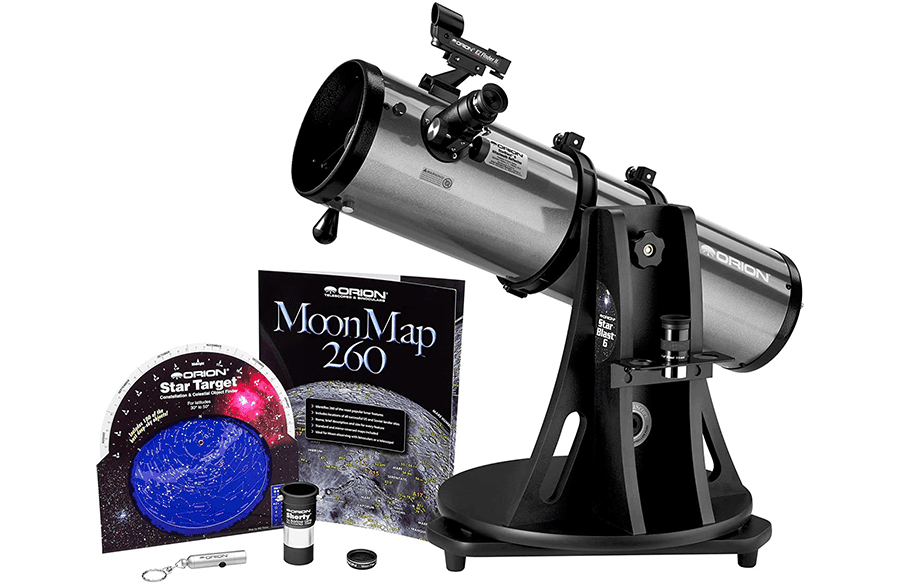The Orion StarBlast 6 is a larger counterpart to the 114mm/4.5” StarBlast unit, and like the 4.5” model, comes in two configurations – albeit drastically less different.
The base StarBlast 6 package can also be upgraded to or purchased as the StarBlast 6i, which has no differences whatsoever apart from adding Orion’s IntelliScope controller and the required hardware to attach it and use it.
As with the regular Orion StarBlast 4.5, the StarBlast 6 is a fast focal ratio (in this case f/5) Newtonian reflector mounted atop a single-armed tabletop Dobsonian mount. These scopes are designed for convenience, portability, and a wide field of view to make it easier to find and view faint deep-sky objects such as nebulae, star clusters, and galaxies.
The StarBlast 6 is the largest tabletop telescope you’re likely to encounter. Compared to a full-sized 6” Dobsonian, the StarBlast 6 is a lot more portable; it fits in a suitcase and can be carried assembled with one hand thanks to its smaller form factor and weight of only 23 pounds.
A full-sized instrument is significantly heavier and more awkward, though, unless you have a readily available place to set the StarBlast 6 on for a convenient height you’ll probably be lugging around some sort of stand for it.
Contents
Orion StarBlast 6 Tabletop Telescope
What We Like
- Good optics
- Wider field of view than many other instruments of this size
- Easy to aim
- Can be upgraded to Intelliscope computer-assisted pointing system
- Good value for the price
What We Don’t Like
- More expensive than a regular 6” scope or even some 8” models
- Needs a steady surface to be set on
- Needs better eyepieces to perform well at low power, and harder to achieve high power than a 6” f/8 Dobsonian or other telescopes with a longer focal length
- Tighter collimation tolerances than a longer focal ratio instrument
How the Orion StarBlast 6 Compares to Similar Products
- Sky-Watcher Heritage 130P – The 130P has a bit less aperture than the Orion StarBlast 6, but is cheaper and much more portable. However, the collapsible tube has some disadvantages compared to a solid-walled tube, which are outlined in our review.
- Sky-Watcher also offers a Heritage 150P, which is essentially the same as the StarBlast optically but inherits the 130P’s collapsible tube and helical focuser.
- Apertura AD8 – The AD8 has more aperture, better accessories, and doesn’t need a table like the StarBlast 6 does. However, it is a bit more expensive and certainly much more bulky compared to the StarBlast 6.
- Celestron NexStar 6SE – The 6SE isn’t appreciably more portable (nor much less portable) than the StarBlast 6, and the views are similar, apart from the 6SE having double the focal length of the StarBlast 6, giving it a narrower field of view. The only real advantage here is GoTo and motorized tracking, which you don’t really need for a 6” telescope.
The Optical Tube Assembly
The StarBlast 6 is optically a 150mm (6”) f/5 Newtonian with a focal length of 750mm. This is quite a bit shorter than the f/8, 1200mm 6” Dobsonians you usually see on the market. Consequently, the StarBlast 6 produces a lower magnification and wider field of view with a given eyepiece, though it’s harder to collimate and cheaper eyepieces such as the included Plossl oculars, tend to have some aberrations visible near the edge of the field of view, particularly at low power.
The StarBlast 6 uses a 1.25” rack-and-pinion focuser as with many cheaper telescopes of this aperture and smaller. It’s a shame considering that an f/5 instrument like the StarBlast would really reap the benefits of wide-angle 2” oculars and a coma corrector; adding one is possible but requires drilling and will prove to be quite an expensive modification.
The included plastic 1.25” focuser is just fine with most eyepieces, however, and is easy to use even when focusing at high magnification. Just take care when storing or transporting the scope; always rack the focuser all the way in when it’s not being used and don’t rest the optical tube in a position where the focuser could be crushed. It’s quite hard to replace or repair the focuser if it’s damaged.
Collimating the StarBlast’s primary mirror doesn’t require any tools such as a screwdriver, though a hex wrench is needed to adjust the secondary mirror. However, it’s unlikely you’ll have to adjust the secondary mirror very often if at all, so this isn’t a huge concern.
Unlike some tabletop instruments which either have the eyepiece located at a fixed angle or a simple plastic clamshell ring, the StarBlast 6 is provided with real metal tube rings allowing you to rotate the optical tube to put the eyepiece in an ideal position as well as slide the scope back and forth for balance.
You could also bolt these rings to a Vixen-style dovetail plate and put it on a variety of interchangeable mounts and tripods. However, the rings also mean you don’t really make the scope package more compact by disassembling it unless you take the rings off the mount with a wrench, which is annoying and time-consuming.
The Mount
The StarBlast 6 uses a single-armed fork mount; whether it’s technically a “Dobsonian” due to the lack of a gravity-based altitude bearing for up-down motion is a matter of nomenclature, but for our purposes it qualifies. The scope pivots up and down on a bolt with some washers and a ball bearing, and swivels sideways using the friction of the mount’s melamine coating against three small Teflon pads.

You can adjust the tension in altitude (up/down) by tightening a large knob while adjusting azimuth requires a pair of pliers, wrenches, and/or a ratchet of some sort. You’ll probably find yourself frequently tightening the altitude axis while changing accessories to avoid the scope moving off-target when the focuser is unoccupied.
The width of the StarBlast 6’s base is such that finding a suitable surface to put the scope on can be tricky. It’s likely too wide for a bar stool or a ledge, so the best solution is probably either going to be a very sturdy table, a homemade collapsible stand, or a milk crate. The milk crate is probably the best of these options, though you’ll have to sit in a chair for it to be a comfortable height.
You could also get a plastic bin to store the scope in and set it atop that, though you’ll need to make sure the top of the bin is stiff enough that the scope doesn’t bounce on it during use.
All of this worry about finding a surface to set the scope on is the biggest drawback of a tabletop mount; critics would argue you’re better off with a wobbly tripod instead, but the annoyance of finding somewhere to put the scope is far less than the frustration of trying to aim a poorly-mounted instrument.
The regular StarBlast 6 comes with everything needed to upgrade the scope to a StarBlast 6i Intelliscope without any disassembly or use of tools. However, this does mean you need to be a little more careful than with a regular Dobsonian in setting up and transporting the scope, as the altitude encoder in particular is easily damaged.
StarBlast 6 Accessories
The StarBlast 6 includes two Plossl eyepieces, both of which are 1.25” barrel diameter. These eyepieces provide 30x and 75x respectively and have an apparent field of view of about 50 degrees. They are good to start with but are not the most well-corrected for such a fast instrument.
You also really will want a Barlow lens and/or additional shorter focal length eyepieces to achieve higher magnifications with the StarBlast 6; the scope can handle up to 300x under ideal conditions, while 150-225x is preferable for most lunar and planetary viewing.
For a finder, the StarBlast 6 includes a simple red dot which is more than sufficient for aiming this telescope thanks to the wide field of view you get at 30x.
The StarBlast 6 includes a basic collimation cap, which works quite well. Orion provides collimation instructions in the manual, too. The collimation cap is really all you need; a laser collimator isn’t the best for the StarBlast as the focuser can wobble just enough to make the laser too inaccurate to be of much use – collimating by eye with the included cap is much easier and less frustrating.
StarBlast 6 Specs
What Can You See With The StarBlast 6?
The StarBlast 6 is made for wide fields of view at low magnification, which is great for viewing large deep-sky objects such as nebulae and open star clusters. With a good nebula filter, you can easily fit one section of the Veil Nebula supernova remnant; the included 25mm eyepiece provides a wide enough field of view to fit the entire Pleiades star cluster (M45) or the Andromeda Galaxy (M31).
You’ll be able to see most of the Messier Catalog of deep-sky objects; the 75x provided by the 10mm eyepiece is enough to start resolving globular clusters like M13 or the spiral arms and dust lanes of galaxies like M51 and M82.
For best results, however, you’ll need dark skies – particularly on galaxies, which probably won’t show much in the way of detail under a light-polluted sky where the Milky Way cannot be detected overhead whatsoever.
Under light-polluted skies, only the cores of the brightest galaxies can be seen, along with maybe a vaguely detectable dust lane in the Andromeda Galaxy at best.
Even under light-polluted skies, the StarBlast 6 won’t disappoint on open star clusters. Thousands can be seen in the night sky, with many boasting hundreds of stars visible in the StarBlast 6. Besides the Pleiades, some of our favorites include M6, M11, and M44.
The StarBlast 6 can show you a few planetary nebulae like the Ring (M57) and the Dumbbell (M27). Smaller planetary nebulae like the Blinking Planetary or the Cat’s Eye may even appear greenish if examined closely, thanks to the spectrum of light they produce.
Within the Solar System, the StarBlast 6 is no slouch either. Though the 75x provided by the included 10mm Plossl isn’t exactly ideal, it’s enough to show a wealth of detail on the Moon and the phases of Mercury and Venus.
You’ll also be able to see the ice caps on Mars when it’s close to Earth, the moons and cloud belts of Jupiter, and the rings and moons of Saturn. Uranus will look like a bluish-green dot, and Neptune will appear as a blue star. Pop in a higher-magnification eyepiece or Barlow lens for say, 150x and you can resolve lunar details just miles across, see dark markings on Mars, view the Great Red Spot on Jupiter and see its moons and their shadows as tiny disks as they transit the planet, and resolve the Cassini Division in Saturn’s rings.
You might also be able to see some cloud belts on Saturn, a few more of its moons, and Neptune’s icy moon Triton visible as a faint starlike point close to the planet.
Final Thoughts on the Orion StarBlast 6

Overall, the Orion StarBlast 6 is a pretty capable package that provides decent value for the price. The biggest drawbacks are its need for better collimation and better eyepieces to provide sharp views and high magnifications and the tabletop mounting debacle.
However, its wide field, portability, and a decent amount of aperture are nothing to sneeze at. But if you want the best views for the price, a regular 6” f/8 Dobsonian – or even better, an 8” or 10” model – might be best for you. If you need the maximum in convenience and portability, one of Sky-Watcher’s Heritage telescopes, either the 130P or 150P, might also be worth considering.

